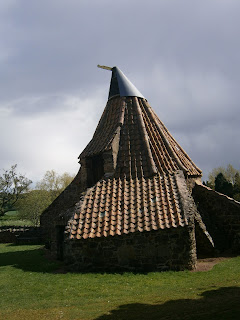 Preston Mill, half a mile to the northeast of East Linton, is an architectural oddity hidden away in a stunning setting surrounded by peaceful countryside walks. This picturesque scene is popular with artists and photographers, the conical roofed kiln and attractive red pantiled buildings beautifully complemented by the nearby millpond with its resident ducks and geese. This is a place to sit awhile, close your eyes and let yourself be carried back through the centuries to the days the mill was at its most prosperous. Listen to the sound of the water, imagine the miller going about his work, feel the sense of history flowing around you.
Preston Mill, half a mile to the northeast of East Linton, is an architectural oddity hidden away in a stunning setting surrounded by peaceful countryside walks. This picturesque scene is popular with artists and photographers, the conical roofed kiln and attractive red pantiled buildings beautifully complemented by the nearby millpond with its resident ducks and geese. This is a place to sit awhile, close your eyes and let yourself be carried back through the centuries to the days the mill was at its most prosperous. Listen to the sound of the water, imagine the miller going about his work, feel the sense of history flowing around you.Preston Mill is one of the oldest mechanically intact water-driven meal mills in Scotland. Grain is thought to have been milled on this site since 1200, with a mill situated here from the late 1500s onwards. The buildings that we see today date from about 1660, with renovation worked carried out in 1749. Further work in 1760 saw a new cast-iron water-wheel put in place, while most of the remaining mill machinery probably dates from the refurbishment of 1909.
So how did this amazing complex of mill, drying kiln and miller's house actually function all those years ago? The mill itself is a rectangular whinstone masonry building, two storeys high, with a distinctive red pantile roof. A walkway leads from the upper floor to the top of the circular buttressed kiln, topped by a conical pantile roof and rotating cowl ventilator driven by a wind vane. Before milling, a coke-fired oven would have dried the oats. Water from the River Tyne flows through via a mill lade, supplying the water wheel by means of a small channel. The mill contained two sets of millstones, one to separate the husks from the shelled oats, another for grinding the oats into oatmeal or oat flour.
The Mill has, however, suffered countless setbacks over the years. Flooding has been a recurrent problem. A particularly severe event in 1948 saw the river rise higher than the Mill's upper storey, submerging all its buildings. Fortunately the Mill was restored to full working order through the generosity of Joseph Rank of Rank Hovis McDougall Ltd. The National Trust for Scotland has owned Preston Mill since 1950, commercial operations ceasing in 1959. If you are fortunate enough to visit the Mill when it is open to the public, you can see and hear the mechanisms of this wonderful mill in action. An exhibition on milling and the life of a miller details the history of Preston Mill and the people who lived and worked here. So are the romantic notions many of us have about the life of a miller true-to-life? Was it really like children's favourite, Windy Miller? The answer has to be no. Heavy lifting, dust, mice, rats and regular flooding made this no walk in the park. Difficult to imagine when you stand back and look at this picture of peace, tranquility and serene beauty today. If you call into East Linton, a delightful village in its own right, please make the short walk to Preston Mill and take a step back in time. You will not be disappointed.



No comments:
Post a Comment